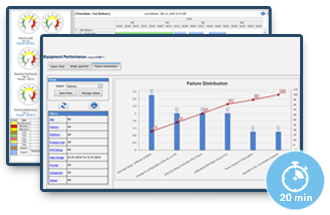

We’ve relied very much over the years on informal “water cooler” or “hallway” conversations to get caught up, coordinate, and build background narratives with our colleagues and teams at work; To check progress and see where people need help. These have been habitual practices that make things work but are now severely curtailed. These conversations help to reduce the “friction” caused by poor communication and coordination in the formal meetings where this is meant to happen. When we can’t be in person, we required new tools & tactics.
Data Inaccuracy…the Root of so Many Problems
The databases we use to manage our businesses are inaccurate to such a degree and with such consistency that they are constant fodder for comic strips. The time, energy, money, and lost opportunities caused by these data inaccuracies however are not funny.

People who use inaccurate/untrustworthy data make equally untrustworthy decisions. These decisions often trigger other unforeseen and cascading conflicts costing additional time, energy, money, and lost opportunity to resolve. The analysis problem becomes much more acute in a world that can’t benefit from the context provided during hallway conversations.
Asset Management Failure: Asset Tracking
Assets are often ascribed characteristics and capabilities they don’t have. For instance, I’ve heard many times how assets “walk”. I can no longer say categorically that they can’t walk, not with robots proving me wrong every day. I can say however that most assets we accuse of walking do not have the capability. That said, the “walk” phenomenon does happen when a person who is committed to producing an outcome requiring an asset with certain capabilities realizes she doesn’t have an asset with the capabilities she needs – but is able to find one somewhere else that is not being used at that moment. This practice has been labeled “midnight acquisition” by many companies. It is common. It is a required skill for another costly habit, hoarding. Hoarding is both the result of data accuracy issues and amplifies those issues…
“Why Would I Beg or Borrow when I can Steal?”
A customer really said this to me. He was serious. Earnest. Hoarding of equipment, labor, or knowledge happens when someone believes it is to their advantage to do so. They don’t trust they will get the assets they need when they need them to get their job done on time and under budget. Why would they, the systems being used to manage assets are notoriously inaccurate and untrustworthy themselves! The uncertainties of our current work environment only add to the overall mood of distrust reinforcing the need to hoard. While hoarding keeps the hoarders cost low it sends cascading costs through the organization hitting where assets are “acquired” and cascading through the organization as victims of hoarding replace the assets they lost with assets from new, unsuspecting victims. Walls, locks, cages, and the like are no match for the engineer in need of equipment, We’ve seen them break into labs through drop ceilings or over fences, stash assets under stairwells, in bathrooms or in “secret undisclosed locations”. Trying to stop an engineer from hoarding is like trying to keep a squirrel out of a bird feeder. It requires skill and cunning!

The Root Cause of Data Inaccuracy Must Be Solved, Not Band-Aided
The root cause of data inaccuracy is that the people who are intended to use the system that stores the data don’t often find the system helpful for producing the outcomes their customers expect of them. They consider updating the database an administrative burden with limited value. RFID is often a band-aid. RFID can often produce the unintended consequence of enabling the hoarder to know where to locate the asset and later prevent RFID readers in his area from doing the same. RFID and other location technology tell you where the asset is, but you have no idea what the asset is capable of, what projects it is committed to in the future, or any maintenance or technical problems it’s had in the past. These can only be solved through user cooperation.
Essential Capabilities for Data Accuracy:
Foundational: A Solution Proven to Enable Outcomes at low cost
Without this, the rest is simply wall dressing. The system and approach must be useful to the user or it will be discarded or avoided. It must help the person navigate today’s changing environment and enable speed and cost competitiveness. Outcomes must be real and measurable, otherwise, why would they use it. If the user needs the system to perform their job their use of the system will keep it accurate.
Accountability Practices and Metrics
Accountability Practices are practices that measure and provide closed-loop feedback on the compliance of system users to agreed-upon aEAM practices and standards. These practices ensure that data is complete and accurate and in the best possible state for decision making. Accountability practices measure leading and lagging indicators of performance as part of a management framework for leading, managing, and governing asset management teams.
Essential Capabilities that are enabled by Data Accuracy
With accurate data these practices can be virtualized, greatly reducing and in some cases eliminating the need to physically touch assets.
Virtualized Resource Planning
This includes searching for capabilities and planning for their use on specific projects for specific durations of time. Project schedules can be integrated by associating assets to project timelines, also managed and coordinated virtually. Gaps in capacity can be quickly identified and planned for through either acquisition of new capacity or disposition of underutilized and no longer needed capacity.
Virtualized Resource Sharing
Enable coordination of sharable assets between groups who are working on staggered schedules to optimize social distancing.
Virtualized Maintenance Management
Planning of maintenance work without the need to coordinate with assets users as asset use requirements are accurately represented in the system and can be used to coordinate most effective times for calibration and maintenance.
Virtualized Management Dashboards and Consoles
Enabling managers working from home to stay connected to the status of work happening at work locations.
Benefits of Accelerated Enterprise Asset Management during COVID-19
- Reduced personal contact resulting from many activities being completely or partly virtualized.
- Reduced delays in projects due to resource constraints
- Improved asset utilization by up to 4X by reducing hoarding
- Reduced calibration and maintenance costs by up to 50%
Request a Demo

See how Scireo aEAM Software drops asset and support costs by 50% while accelerating time-to-market 2X.
Relevant Content
Covid-19 and The Urgency for Change. Finding & Navigating Dangerous Bumps!
Businesses have been grappling for years with changes in technology and practices driven by the new competitive requirements of the 4th Industrial Revolution (IR4). Then the Covid-19 pandemic appeared and that urgency drove new practices because they were required immediately to continue operations. The pandemic has kicked off a race for improvements and digitization that…
Every Environment is Someone’s Production Environment
Any complete definition of “Production” must include work that supports the making of some thing or service. That inclusion opens up “production” to include everyone’s work – it really includes your company’s whole supply chain. Wherever work is done is some form of production environment. If that environment (e.g.: computer, truck, instrument, lab space, test…
The Pandemic Has Exposed Asset Management Failings & Opportunities
The Covid-19 pandemic has been a huge disruption, but if we are honest it has already shown us how unprepared we are to react to quickly changing events effectively. This capability to adapt is a competitive necessity today with or without the pandemic. To compete in the 4th Industrial Revolution requires resilience and speed and…
Introducing Accelerated Enterprise Asset Management – aEAM
Asset-Intensive operations have their own set of unique challenges when considering how they will be transformed for speed and cost competitiveness post-Covid-19. aEAM is looking like an answer to CEOs who, emboldened by the initial adoption of collaboration tools made necessary by Covid-19, intend to accelerate broader changes required to drive speed and efficiency into…
Notable Quotes
“If users want to know exactly what assets were used on the test, their calibration/maintenance status, who performed the test, on what units, for which programs and what the results were the eLab Log integration with other modules makes this query simple – reducing the time from test completion to report generation by 50 percent”
Frost & Sullivan Analyst









